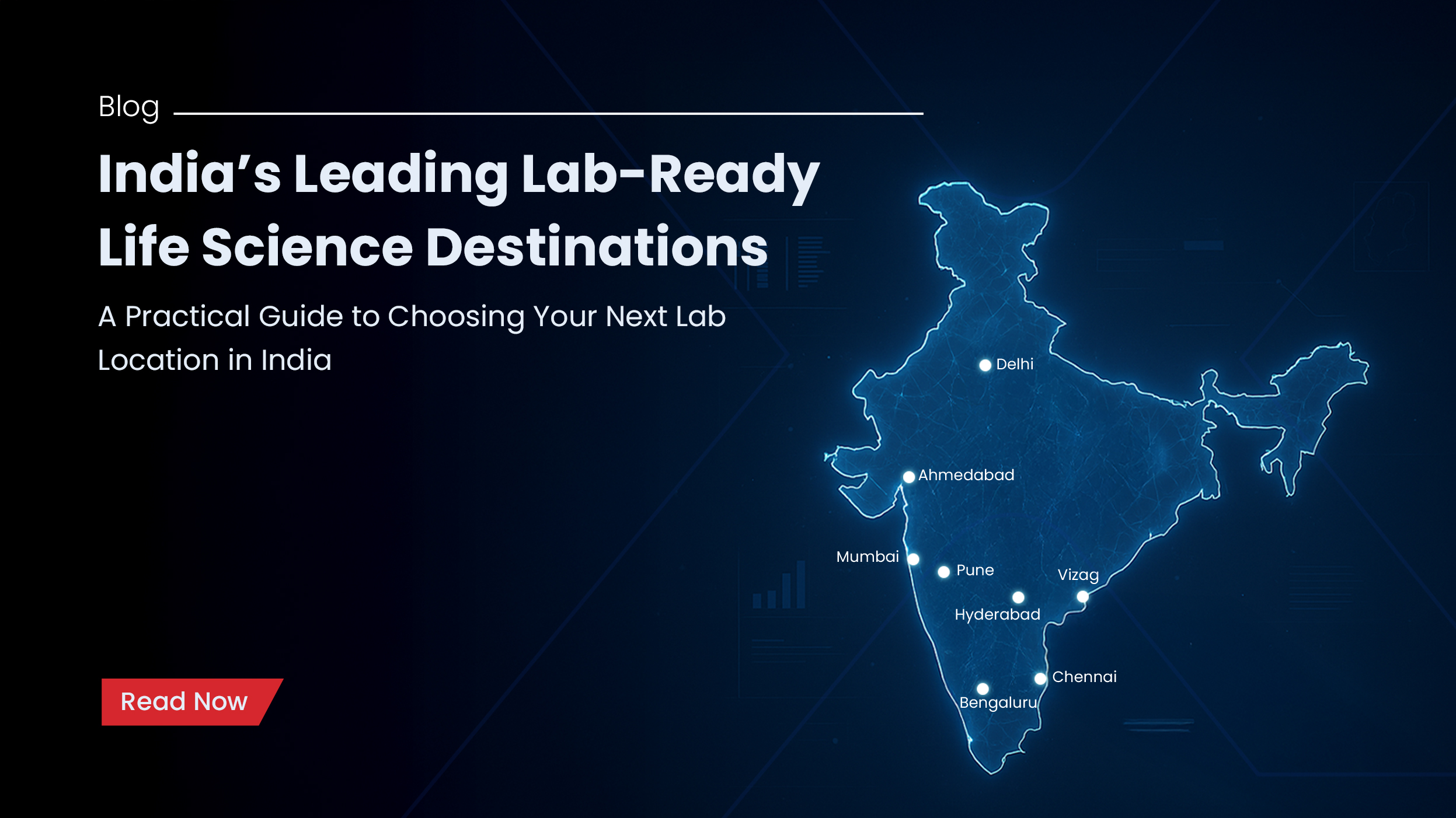
In life sciences, geography isn’t just a backdrop — it is a strategic advantage. The success of any R&D or manufacturing program depends not only on scientific excellence but on the ecosystem that surrounds it: talent, infrastructure, policy environment, supply-chain readiness, and connectivity. Location influences everything — from access to researchers and regulators to technology transfer timelines and operational reliability. The right ecosystem accelerates discovery, strengthens resilience, and amplifies capital efficiency. In India, a new generation of life-science hubs is translating scientific ambition into scalable outcomes, powered by specialised infrastructure and maturing innovation networks.
Below is an overview of the leading cities shaping India’s life-sciences landscape:
Hyderabad — The Pharma Capital of India
Hyderabad remains one of India’s most mature life-sciences ecosystems, anchored by Genome Valley, the country’s first purpose-built R&D cluster with more than 200 research-driven organisations. Beyond Genome Valley, activity extends across Patancheru, Uppal–Nacharam, and the Sultanpur Medical Devices Park. Supported by the Telangana Life Sciences Policy 2030, Hyderabad now operates as an integrated continuum linking early discovery, applied research, biotechnology, and large-scale manufacturing. Within this landscape, Rx Propellant’s warm-shell, compliance-ready developments in Genome Valley provide the operational flexibility and commissioning speed that modern R&D teams require.
Bengaluru — Convergence Hub for Biology and Computation
Bengaluru has emerged as India’s deep-science capital, where biology, computation, and engineering intersect. The city benefits from a strong foundation of research institutions, bioinformatics expertise, and a thriving startup ecosystem. It is also a national hub for data-driven drug discovery, bio design, computational biology, and platform engineering — making it one of India’s most dynamic environments for translational science. To support this growing convergence, Rx Propellant is planning a new life sciences campus in Bengaluru, built around flexible warm-shell laboratories designed for scientific agility, rapid scale-up, and efficient tech transfer.
Mumbai & Navi Mumbai — India’s corporate and R&D epicentre
Mumbai anchors India’s life-sciences value chain through its concentration of corporate headquarters, capital markets, regulatory advisors, and scientific leadership. It remains a preferred location for strategy, regulatory coordination, and global functions. Navi Mumbai has emerged as a complementary hub for R&D, quality operations, and scale-up — supported by strong connectivity and proximity to western India’s manufacturing belt. At the centre of this ecosystem is the Navi Mumbai Research District (NMRD), developed by Rx Propellant as the region’s largest integrated R&D-focused infrastructure. It enables scientific teams to operate seamlessly in spaces designed for compliance, safety, and operational efficiency.
Ahmedabad — The Heart of India’s Drug Manufacturing Engine
Ahmedabad forms one of India’s largest pharmaceutical manufacturing corridors. The region integrates R&D facilities, scale-up centres, and full-scale GMP manufacturing across APIs, formulations, biologics, and specialty chemicals. Gujarat’s strong industrial policies, logistics infrastructure, and regulatory efficiency have enabled companies to shorten technology-transfer cycles and improve operational reliability. This corridor’s strength lies in its ability to support end-to-end development — from early-stage research to commercial production.
Delhi NCR — India’s Regulatory & Clinical Gateway
Delhi NCR is India’s policy, regulatory, and clinical nerve centre. It is home to national regulators, translational research institutes, and some of the country’s most respected clinical networks. The region offers unique proximity to policymakers, ethics committees, clinical research organisations, diagnostics ecosystems, and public-health institutions — making it ideal for organisations that require rapid validation, approvals, or clinical partnerships.
Visakhapatnam — Coastal Bulk Drug & MedTech Powerhouse
Visakhapatnam has become a major node in India’s bulk-drug and medical devices supply chain. With large-format industrial parks, integrated utilities, and excellent port connectivity, it supports high-throughput manufacturing, export-oriented operations, and MedTech scale-up. The Bulk Drug Park in Nakkapalli and the MedTech Zone (AMTZ) have positioned Vizag as a strategic location for cost-efficient production and supply-chain optimisation.
Pune — Engine for Biotech and Vaccine Advancement
Pune anchors India’s vaccine, biologics, and biotech innovation landscape. It hosts large-scale manufacturing, RNA and viral-vector research, formulation development, and significant biotech startup activity. Pune’s academic institutions, biotech parks, and translational research centres enable collaboration across early discovery, preclinical work, and process development — making it a preferred destination for biologics and next-generation vaccine platforms.
Chennai — The Technology-Driven Life Sciences Frontier
Chennai sits at the intersection of biopharma, advanced engineering, analytics, and digital technologies. It has a growing presence in MedTech manufacturing, bioengineering, digital health, and global capability centres. The city’s strong engineering talent pool, logistics infrastructure, and cost-efficient operations make it an emerging hub for integrated R&D, data-driven platforms, and enterprise-scale scientific operations.
India’s Integrated Life-Sciences Corridor
India’s life sciences geography is no longer a set of isolated hubs; it is an interconnected national innovation corridor linking discovery, development, validation, and delivery.
• South: Hyderabad, Bengaluru, Visakhapatnam, Chennai
• West: Mumbai, Pune, Ahmedabad
• North: Delhi NCR
These clusters complement one another, forming an ecosystem where scientific ideas can move efficiently across stages and geographies. At the centre of this transformation, Rx Propellant is building compliance-ready, scalable warm-shell infrastructure that keeps science moving from blueprint to bench to business without friction.
Conclusion — Infrastructure That Powers Innovation
India’s life sciences landscape is entering a pivotal phase — one where infrastructure is as strategic as discovery itself. Scientific progress depends not only on new ideas but on environments that support speed, precision, compliance, and collaboration. Across India’s major clusters — from Hyderabad’s R&D strength to Pune’s biotech depth, from Bengaluru’s computational edge to NCR’s regulatory leadership — the lesson is consistent: innovation thrives when the ecosystem is designed for it.
At Rx Propellant, we see ourselves as ecosystem enablers. Our campuses are designed as scientific platforms combining compliance-by-design, scalability, and operational readiness — so organisations can focus on research rather than real estate constraints. As India becomes one of the world’s most dynamic life-sciences economies, progress will increasingly depend on the infrastructure that connects discovery, development, and delivery. Because in science — as in geography — progress depends on what connects, not just what exists.

